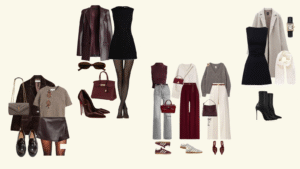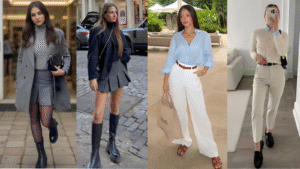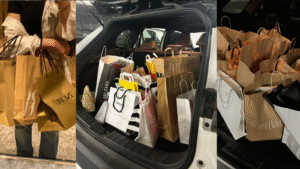Here’s Why It Happens—and How to Shop Smarter: 56% of shoppers regretted an impulse fashion purchase:
A significant number of shoppers experience regret after making impulse fashion purchases. In fact, 56% of shoppers regretted an impulse fashion purchase, according to recent studies. In a world where fast fashion, influencer culture, and one-click checkout dominate, this stat might not be surprising, but it’s still jarring. If more than half of us regret what we buy on impulse, what does that say about our habits, the industry, and our sense of value?
Let’s dig into why impulse shopping leads to regret, what psychological tricks retailers use to trigger those “Add to Cart” urges, and how you can build mindful shopping habits without sacrificing your style or spontaneity.
Why Do We Regret Impulse Purchases?
There are a few common threads behind impulse regret, especially when it comes to fashion:
1. Emotional Spending
We often shop when we’re bored, stressed, or seeking a dopamine boost. While retail therapy might give us a quick mood lift, it doesn’t last—and neither does the satisfaction from that purchase. What seemed like a “treat” in the moment quickly becomes clutter in the closet.
2. The Illusion of Savings
Sales and limited-time offers create urgency and FOMO (fear of missing out). How many times have you bought something just because it was 40% off—only to realize you didn’t need or even really want it? Discounts manipulate our sense of value, leading us to prioritize the deal over the product.
3. Overexposure to Trends
Thanks to social media and influencer marketing, we’re constantly bombarded with images of trendy outfits, “must-haves,” and haul videos. The result? We want things we didn’t even know existed five minutes ago. But trends fade fast, and impulse buys rarely align with our long-term style.
How Fashion Retailers Encourage Impulse Buying
Fashion brands are masterful at encouraging impulsive behavior. Here’s how they do it:
- Scarcity tactics: “Only 2 left in your size!” triggers panic and urgency.
- Free shipping thresholds: Encouraging you to add “just one more item” to reach a $50 free shipping mark.
- Buy now, pay later options (BNPL): Making a $200 haul feel like a $50 purchase.
- Personalized retargeting ads: Following you around the internet with the item you almost bought.
- Social proof: Reviews and “trending now” tags increase perceived desirability.
It’s not just your willpower at work here—it’s sophisticated design, psychology, and tech built to make you click.
What Regret Really Costs
Regret doesn’t just lead to cluttered closets. It has emotional and financial costs, too.
- Guilt and stress: Buying things you don’t need can lead to guilt, especially if you’re trying to save or stick to a budget.
- Decision fatigue: Constant exposure to options erodes our ability to make confident choices.
- Environmental waste: Many impulse fashion purchases are worn only once—or not at all—and contribute to the mounting waste of the fast fashion industry.
According to the EPA, Americans throw away over 11 million tons of textile waste each year. Impulse buying plays a major role in this growing issue.
How to Curb Impulse Buying Without Losing Your Style
✨ Build a wardrobe you’ll love with fewer, better pieces. Check out our capsule collections to simplify your style. Start your capsule →
You don’t have to become a minimalist or swear off fashion entirely to avoid impulse regret. Here are smarter strategies that keep your wardrobe fresh and intentional.
1. Set a Monthly Fashion Budget
Decide in advance what you’re willing to spend. Apps like YNAB or Mint can help you track and allocate spending across categories. Treat your fashion budget like a non-negotiable cap—if it’s gone, it’s gone.
2. Create a Wishlist, Not a Cart
Instead of buying immediately, save items to a wishlist or Pinterest board. Revisit them in a week. Do you still love them? Or was it just a passing moment?
3. Buy Full Outfits, Not Orphans
A single trendy piece may look great in theory but be impossible to pair with what you already own. Try planning outfits ahead of time or following the “rule of three”: Only buy something if you can wear it in at least three different ways.
💡 Tired of random buys that don’t go together? Explore our ready-made outfits designed to mix, match, and last. Shop curated looks →
4. Embrace the 24-Hour Rule
Wait 24 hours (or longer) before buying anything unplanned. It gives your logical brain time to weigh in before your emotional brain hits “Buy Now.”
5. Use the ‘Cost Per Wear’ Metric
Instead of judging an item by price alone, consider how often you’ll wear it. A $100 jacket worn 30 times costs $3.33 per wear—while a $20 neon crop top worn once costs more.
When Impulse Isn’t Bad
Sometimes, a spontaneous fashion buy can feel like magic: the perfect dress for an unexpected event, or a bold piece that makes you feel more like you. The key difference is intention—not all impulse purchases are regrettable if they’re rooted in self-awareness, not emotional escape.
If an item makes you feel confident, is high-quality, and fits well into your wardrobe, it might be a delightful surprise rather than a mistake.
Fashion Mindfulness Is a Trend Worth Following
Mindful fashion doesn’t mean you stop shopping. It means you start aligning your purchases with your values, needs, and identity. Here’s what that could look like:
- Support ethical or sustainable brands.
- Buy fewer, better-quality pieces.
- Curate a personal style over chasing every trend.
- Take pride in outfit repeating and creative styling.
The fashion world may encourage “more, faster, now”—but your closet doesn’t have to.
Final Thoughts: 56% of shoppers regretted an impulse fashion purchase.
The statistic is clear: More than half of shoppers regret their impulse fashion purchases. But with a few mindset shifts and practical tools, you can avoid buyer’s remorse and start making fashion choices that truly serve you.
After all, the best wardrobe isn’t just full—it’s full of clothes you love to wear.




